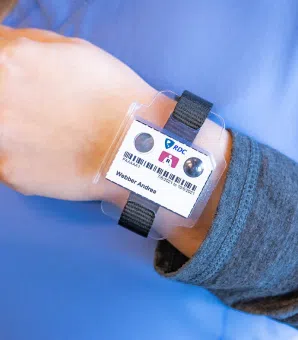
Dosimeter badge services for medical, dental, and veterinary businesses
Learn how Radiation Detection Company’s easy-to-use dosimetry solutions can boost the efficiency of your practice.

Providing dosimetry solutions is our business, so we wanted to share the intricacies of dosimetry with you. Whether you're new to radiation monitoring, or you're a seasoned veteran, we believe this article will serve as your one-stop shop for all things dosimetry.
We hope you find this article informative, and as always, we look forward to hearing your feedback!
Dosimetry (also known as radiation dosimetry) is the accurate and systematic measurement, calculation, and assessment of the ionizing radiation dose absorbed by matter or tissue. Ionizing radiation is high-energy radiation. This includes x-ray, beta, gamma and neutron radiation, capable of producing ionization in the substances it passes through. In this case we are talking about the energy deposited from the radiation in human tissue.
Dosimetry includes internal absorptions (ingested, injected, absorbed or inhaled radioactive substances), and external radiation dose due are from sources external to the body. This can include cosmic radiation, natural radioactive material (which could be found in building materials and soil onsite), and occupational or medical sources of radiation external to the body.
Internal dosimetry assessment relies on a variety of monitoring, bioassay, and/or radiation detector counting techniques. External dosimetry is based on measurements with a dosimeter or inferred from measurements made by other radiological protection instruments. A dosimeter is a device used to measure the absorbed dose of ionizing radiation.

Radiation Detection Company is dedicated to keeping you and all your employees safe. We have almost 75 years of experience providing quality dosimetry service to over 27,000 companies nationwide.
RDC offers a wide range of affordable and comprehensive radiation badge services to accommodate the needs of any organization, big or small. We also recognize that choosing a solution can be intimidating. If you need help understanding your dosimetry needs, please contact our world-class customer service team. They will be happy to provide guidance.
Our standard OSL badge (or Type 84 badge for photon monitoring) is a 2-element beryllium oxide (BeO)badge with a minimum reportable dose of 10 mrem (0.10 mSv), and a LLD of 1 mrem. These badges are used to monitor occupational exposure to a single individual working with radioactive materials to ensure the dose received remains within the allowable Dose Limits. The BeO OSL dosimeter is optimal for medical practitioners and technologists including veterinarians, dentists, chiropractors, mammography, fluoroscopy, or any practice with potential exposure to photon.
In reference to external radiation exposures, “whole body” is considered to be the head, torso, arms above the elbow, or legs above the knee.
The TLD-XBG is a four-element radiation badge with a minimal reportable dose of 10 mrem (0.10 mSv) and a lower limit of detection of 1 mrem (0.010 mSv). These badges are used to monitor occupational exposure to a single individual working with radioactive materials to ensure that the whole-body dose received remains within the allowable dose limit.
Our XTLD-XBG extremity is a single element ring dosimeter for extremities. The ring badge is optimal for radiation workers whose job functions potentially require their fingers, hands, arms, toes, feet, or legs likely to receive radiation exposure above established monitoring requirements. The XTLD-XBG is a one-element radiation detector with a minimal reportable dose of 10 mrem (0.10 mSv) and a lower limit of detection of 5 mrem (0.05 mSv). These employees may benefit from a ring badge to ensure the extremity dose received remains within the allowable dose limit.
Our TLD-XBGN is a four-element dosimeter badge with a minimal reportable dose of 10 mrem (0.10 mSv) and a LLD of 1 mrem (0.010 mSv). The badge is fitted with a Velcro strap to be worn around the wrist. The wrist badge is ideal for radiation workers whose arms may receive a higher exposure if dexterity is a concern. The wrist badge helps ensure the extremity dose received remains within the allowable dose limit.
Our TLD-XBGN fetal monitor is a four-element radiation badge with a minimal reportable dose of 10 mrem (0.10 mSv) and a LLD of 1 mrem (0.010 mSv). Fetal Monitors are available for radiation workers who are pregnant to ensure that the fetus does not exceed a significant radiation dose of 500 mrem for the entire gestational period or 50 mrem per month. The badge should be worn on the abdomen to provide the best estimate of the dose to the embryo/fetus.
Area Monitors can be used to ensure that the public is not being exposed to more than 100 mrem/year from outside a room/building. In addition, they can monitor occupational dose to employees in a room where the source is located or a room near a source that radiation could potentially reach.

The U.S. Nuclear Regulatory Commission (NRC) has established dose limits for occupational exposure for people working with radioactive materials or ionizing radiation (such as x-ray imaging equipment) and external beam radiation therapy. The dose limit functions as a form of radiation protection for personnel monitoring. Radiation dose is often reported in rads, and the dose equivalent is recorded in rems. If you or your staff are working with such materials or equipment, these regulations apply and must be followed.
There are several ways to measure absorbed doses from ionizing radiation. People in contact with radioactive substances in the course of their employment - or people who may be exposed to radiation - normally carry personal dosimeters. These dosimeters are specifically designed to record and indicate the radiation dose received.
In the past, personal dosimeters were generally devices fastened to the external clothing of the person being monitored. The devices contained photographic film, and these instruments were known as film badge dosimeters.
Today, the film badges of the past have been largely replaced by devices such as the TLD badge. Which these TLD badges use Thermoluminescent dosimetry.
The measure of the radiation energy deposited in matter by ionizing radiation per unit mass. Absorbed dose is a measurable quantity and a key component of radiation protection as well as radiology.
A crucial piece of radiological protection, effective dose is a calculation that sums up all of the different exposures into a single measure that generally reflects the overall risk for the whole body.
The sum of the products of the dose equivalent to the organ or tissue (HT) and the weighting factors (WT) applicable to each of the body organs or tissues that are irradiated (HE = ΣWTHT).
A measure of the biological damage to living tissue as a result of radiation exposure. Also known as the " biological dose," the dose equivalent is calculated as the product of absorbed dose in tissue multiplied by a quality factor and then sometimes multiplied by other necessary modifying factors at the location of interest.
Background radiation is a measure of the level of ionizing radiation present in the environment at a particular site. Which this occurs naturally and is not due to deliberate introduction of a radiation source. A Control Dosimeter is a badge that is fundamentally the same as the radiation badge used to protect radiation workers. However, Control Dosimeters are used to measure external radiation exposure from non-occupational radiation sources. (while the badge worn everyday measures occupational exposure and background radiation). Subtracting from the dosimeter worn by the worker yields the occupational dose.

Occupational dose is the amount of ionizing radiation exposure (which includes gamma rays) received by workers in the course of their employment. A control dosimeter measures the background radiation dose received during shipment (either to you or back to us) and storage. To obtain occupational dose, the measurement recorded on the control dosimeter is subtracted from the individual doses recorded on each badge in the group.
Maintaining a compliant dosimetry program is crucial for all businesses that use radiation in their operations. A dosimetry program helps ensure that levels of occupational dose are kept within safe limits. This in turn helps to protect your employees from the potential health risks associated with radiation exposure.
It's extremely important that your dosimetry program is reliable and accurate. Your employees need to understand its function and they are properly trained. Businesses that don’t comply with dosimetry requirements face a number of implications that can negatively impact the success of the company and regulatory compliance.
As we detailed in our recent blog titled "5 Challenges Companies Face When Out Of Compliance With Their Dosimetry Program," we provide 4 tips to maintain a compliant dosimetry program:
Want to learn more about RDC’s dosimetry badge solutions? Please visit our Solutions page to view our full suite of offerings. Have a question that we did not address in this article? Please reach out to our Customer Care team, and one of our specialists will be happy to assist you.
Learn how Radiation Detection Company’s easy-to-use dosimetry solutions can boost the efficiency of your practice.